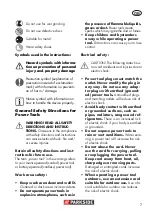
1 2
GB
into the workpiece or blocks it, the edge of
the grinding disc that digs into the work-
piece can get caught and, through that,
break off the grinding disc or cause a kick-
back. The grinding disc then moves towards
or away from the operator, depending on
the direction of rotation of the disc at the
blocked spot. Here, the grinding discs can
also break. A kickback is caused by wrong-
ly or incorrectly operating the electric tool.
It can be avoided by suitable cautionary
measures, such as described below.
a) Hold the electric tool very firmly and
bring your body and your arm into a
position in which you can resist the kick-
back force. Always use the supplemental
handle if available to give you the best
control over kickback force or reaction
time during acceleration. The operator
can master the kickback and reaction
force through suitable precautions.
b) Never bring your hands near a rotating
attachment tool. The attachment tool
can run over your hand in the kickback.
c) Keep your body away from the area
in which the electric tool would move
during a kickback. The kickback drives
the electric tool in the counter-direction
to the rotation of the grinding disc at
the blocked spot.
d) Work particularly cautiously in corner
areas or where there are sharp cor-
ners etc. Prevent the attachment tools
from recoiling from the workpiece and
jamming. The rotating attachment tool
tends to jam when near corners, sharp
edges or when it recoils from such. This
causes a loss of control or kickback.
e) Do not use chain or toothed saw bla-
des. Such attachment tools frequently
cause a kickback or loss of control over
the electric tool.
Special safety instructions for
grinding and cutting
a) Use only grinders which have been
approved for your electric tool and the
protective hood intended for these grin-
ders. Grinders which are not intended
for the electric tool may not be suffici
-
ently shielded and are unsafe.
b) Depressed Center grinding wheels must
be pre-assembled so that their surface
not above the level of the edge of the
guard stands out. An improperly moun-
ted grinding wheel, which extends bey-
ond the level of the edge of the guard,
not sufficiently shielded.
c) The protective hood must be securely
attached to the electric tool and adjus-
ted so that the greatest level of safety
is reached, i.e., the smallest possible
amount of the grinder is exposed to the
operator. The protective hood should
protect the operator from broken bits
and accidental contact with the grinder.
d) Grinders may only be used for the
recommended attachment options. For
example: Never grind with the side
surface of a cutting disc. Cutting discs
are for cutting material using the edge
of the disc. Pushing sideways on these
grinders can break them.
e) Always use undamaged clamping flan
-
ges of the correct size and shape for
the grinding disc you selected. Suitable
flanges support the grinding disc and
thus reduce the danger of the grinding
disc breaking. Flanges for cutting discs
can be distinguished from flanges for
other grinding discs.
f) Do not use worn grinding discs for
larger electric tools. Grinding discs for
larger electric tools are not set up for
the higher rotation speeds of smaller
electric tools and can break.
Содержание PWS 125 D3
Страница 3: ...1 2 3 4 8 9 7 5 6 11 12 13 14 19 18 17 22 21 20 15 16 25 24 23 10 ...
Страница 62: ...6 2 S I ...
Страница 126: ...126 ...
Страница 128: ...128 ...













































